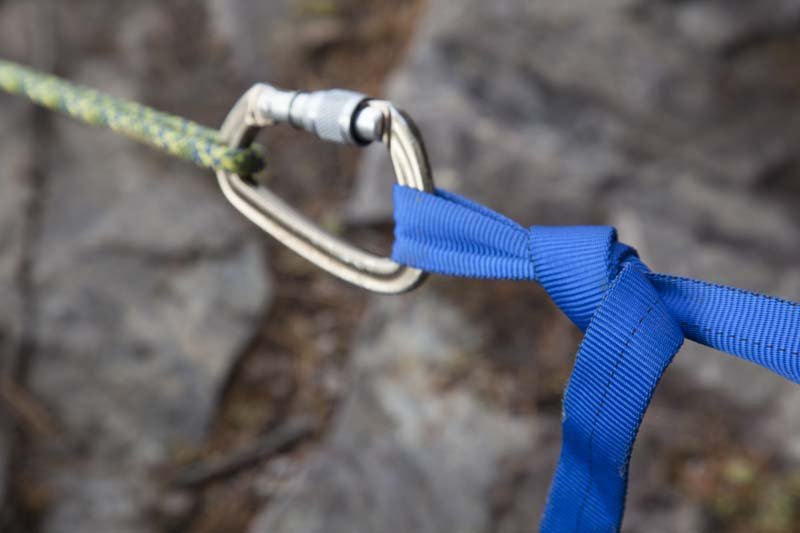21 Rock Climbing Knots and Their Uses
While most of our trips or classes do not require previous knowledge of knots, we recommend students study beforehand so we can make the most of our class time together. Anchors students who already know the required knots save an hour or more of knot instruction throughout the day.
I've organized the below knots into groups appropriate for various levels of climbing progression. When available, knots are illustrated via Animated Knots by Grog, arguably the best climbing knot learning resource on the web. All you'll need is one or two 10-foot sections of thick rope (it does not have to be climbing rope, but it helps to have rope at least 7mm thick) and you can learn all these knots on a rainy evening. Have fun and practice lots.
Basic Knots for Beginning Climbers
Figure Eight The foundational knot for the Figure Eight Follow-Through (see next knot). Animated Lesson
Figure Eight Follow-Through The best tie-in knot for beginning climbers. Super-strong and fairly easy to tie, the Figure Eight Follow-Through connects a climber's harness to the climbing rope. Animated Lesson
Double Fisherman's (Grapevine Knot) The most common way to tidy up extra tail from your Figure Eight Follow Through. Often called a "back-up" knot, the Double Fishermen's does not really back anything up (a well-tied Figure Eight will not fail) but the notion is popular and it does look neat. Animated Lesson
Girth Hitch (aka Lark's Foot) The most common way to attach a safety tether (aka personal tether, personal anchor) to your harness. A safety tether is a great piece of gear to install whilst top-rope cragging, as it makes clipping into safety lines easy when setting anchors or doing other edge work. Animated Lesson
Intermediate Knots for Building Climbing Anchors
Overhand Knot Another foundational knot (like the Figure Eight) that helps you build other knots. If you say to most people, "Put a knot in this rope," this knot is what they will typically tie. Animated Lesson
Overhand on a Bight Key knot in both webbing and rope that creates an attachment point for a carabiner.
Figure Eight on a Bight Similar to the Overhand on a Bight, this knot creates a beefier connection point that is easier to untie after being pulled tight while holding a heavy load.
Figure Eight Double Loop (aka Super Eight, Hungry Eight or Bunny-Ears Eight) A variation on the Figure Eight on a Bight that has doubled ropes at the attachment point, enabling connection to two different primary anchors/carabiners.
BHK Knot (aka Master Point knot) The “Big Honking Knot” can be either an overhand or a figure eight tied on a doubled bight, meaning you first make a long, single bight, then fold THAT bight over again to make another bight of the first bight. In the end, you should have four strands of rope. Tie an overhand or an eight, and you'll have one end with double loops; the other end has a single loop sticking out of it, plus two single strands. Take care to "close the system" by making sure the single loop cannot back-out of the knot.
Bowline Connects a rope around a tree, boulder, or other immovable, un-openable object. Easy to untie, even after holding a heavy load. More difficult than most knots here to identify when tied incorrectly. Experienced climbers use the bowline as their tie-in knot because it's easy to untie even after taking many falls. Animated Lesson
Alpine Butterfly Creates an in-line attachment point in a weight-bearing line. Good knot for creating safety clip-in points while setting anchors. Animated Lesson
Flat Overhand (aka European Death Knot) Simple, elegant knot for tying two ropes ends together. Used for connecting two ropes to create a longer one (e.g. rappelling situation) or creating a circular cordelette in a rope or smaller cord. There is nothing deadly about this knot, despite the egregious nomenclature, though it is important to leave long tails in case the knot inverts/flips. Animated Lesson
Water Knot (webbing) Best knot for connecting two ends of webbing. Can be used to create a loop of webbing or extend a linear piece of webbing by adding another. Animated Lesson
Daisy Chain or Electrician's Braid Common way to braid webbing or rope so it stays organized, unknotted, and easy to carry. Animated Lesson
Clove Hitch Essential anchoring knot. Creates a strong, fast fixed point that can be adjusted easily. Animated Lesson
Advanced Knots for Rescue and Rigging
Münter Hitch Great tension hitch for belaying and rappelling. A must-know knot for the inevitable day you misplace/drop/forget your belay device and need a simple, elegant back-up solution. This hitch is not often used in bottom-managed top-rope scenarios, as the Munter Hitch tends to twist up climbing ropes, but the Münter is common in multi-pitch guiding situations and well-managed rappelling classes for beginners. Animated Lesson
Münter-Mule-Overhand Knot This knot allows you to tie-off your Münter Hitch to "fix" or isolate the line. Animated Lesson
Tensionless Hitch Nice method of attaching static line to a tree without using an intermediary sling or webbing. Animated Lesson
Prusik The most famous and strongest-holding rope gripping hitch. The Prusik can be difficult to release and move after being loaded, which is why the below hitches may be preferable, depending on your application. Animated Lesson
Klemheist Another rope-gripping hitch that is a little easier to release/slide than the Prusik. Animated Lesson
Bachmann Yet another rope-gripping hitch that uses a carabiner, which makes it easier to release/slide when you want to move it.
Autobloc My favorite rope-gripping hitch for backing up a rappel. When mastered, the Autobloc allows you to rappel faster than without it because the heat of friction is absorbed by the cord, not your hand. The benefit of being able to stop and go hands-free at will is helpful on rappel, especially when you need to stop and untangle rope, assist another climber, or take pictures on the way down.



